We’ve talked about current trends in the industry, about the optics of tomorrow. But what about tomorrow’s tomorrow? What technologies will shape our lives in the next 20 to 50 years?
Let’s just get this out of the way now: We aren’t going to see flying cars in the next 20 to 50 years. I know, I know, Back to the Future Part II (1989) told us we’d be rocketing around in souped-up DeLoreans within Marty McFly’s lifetime. But that movie told us all kinds of things – such as faxes would be the preferred form of communication in the 21st century.
The good news is that we will see a broad range of optics-based innovations in the automotive industry that don’t involve flying. One example: the total elimination of blind spots using cameras and software specially developed to combine imaging data, even allowing drivers to see around objects.
Another: autonomous driving. Imagine your car driving itself around town, knowing not only where it’s going, but also when the traffic light is about to change, which of the pedestrians on the sidewalk is likely to step into the street, and why that joker in front of you isn’t driving any faster.
Photonics, interleaved with other types of technology, will play a key role in enabling autonomous driving, said Thomas M. Baer, executive director of the Stanford Photonics Research Center in California. Ranging and imaging systems will provide a continuous stream of information about the current status of pedestrians and other potential obstacles, updating 3-D databases – much like Google Maps – that characterize the local environment down to a few centimeters. At the same time, intercommunication with other vehicles through optical connects will provide information about what those vehicles are doing – information about when and even why they are accelerating or braking, for example.
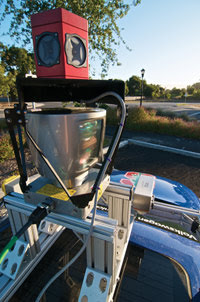
Stanford’s Junior 2 uses an array of sophisticated sensors to facilitate its fully autonomous driving. Courtesy of Stanford Artificial Intelligence Lab.
This isn’t just a fantasy, the subject of some long-forgotten attraction in Disney’s Tomorrowland. “I’m glad you asked about that particular time frame,” said Sven A. Beiker, executive director of the Center for Automotive Research at Stanford, when I inquired about automotive applications of optics in the coming decades, “because 20 to 50 years from now, we really will see fully autonomous vehicles.”
Beiker and Baer know what they’re talking about. The centers are joining forces to improve vision-based vehicle systems even further. Stanford has been at the forefront of autonomous driving research for some time – famously so since the Stanford Racing Team and its car, Stanley, won the 2005 DARPA Grand Challenge, the goal of which is to fund research to develop autonomous vehicle technology that will help to keep soldiers off the battlefield (see “On the Road with Junior: A tale of optics and driverless cars,” Photonics Spectra, October 2010, p. 34). Many of the systems that will facilitate autonomous driving in the future can already be found in their research vehicles.
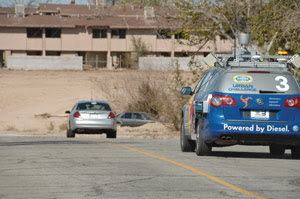
The DARPA Urban Challenge featured 11 driverless vehicle finalists competing in a race to complete a number of maneuvers, including passing, parking and negotiating intersections, thus demonstrating the feasibility of autonomous driving. Shown are Stanford Racing Team’s and Team VictorTango’s (Virginia Polytechnic Institute) cars together at an intersection. Courtesy of DARPA.
Of course, what works in research vehicles isn’t necessarily appropriate for production cars. For example, both Stanley and Junior, Stanford’s next-generation autonomous vehicle, which placed second in the 2007 DARPA Urban Challenge held at the former George Air Force Base in Victorville, Calif., relied on arrays of sensors and positioning systems, housed in a mechanical device, that sit atop the cars.
Junior 2’s sensor suite centers on a Velodyne HDL-64E S2 lidar sensor that provides 1.3 million returns per second from 64 beams, with a range of ~100 m. It also includes six Bosch production automotive radar units for tracking vehicles, especially at longer ranges, and two Sick Inc. LD planar lidar scanners for near-field detection on the sides and rear of the car. Four Point Grey Research Inc. cameras are used for passive vision: a Ladybug3 spherical vision head mounted just above the Velodyne with six 2-mega-pixel cameras to provide a full view around the car; a pair of 2-megapixel forward-facing cameras for stereo vision; and a 15-Hz 5-megapixel forward-looking color camera.
But such a system could not be used in production cars.
“This is where we will need to see a lot of development and improvement of systems,” Beiker said, adding that cars of the future might rely on scanning lasers with no moving parts, for example.
Although the very idea of autonomous driving suggests applications such as self-parking cars, which are being tested today, and fighting crime with David Hasselhoff, which, to my knowledge, is not, the impact of the technology likely will be most profound under normal driving conditions, with considerable improvements in fuel efficiency, safety and traffic congestion.
So-called “smart cars” simply will drive more efficiently than humans do now, using different and more sensible patterns of accelerating and braking. At the same time, vehicle-to-vehicle communication through optical interconnects will enable “highway trains,” with cars traveling very close to one another at high speeds. This could lead to fewer accidents – with vehicles slowing automatically if a car brakes suddenly somewhere up ahead – as well as to increased fuel efficiency. Vehicle-to-vehicle and vehicle-to-infrastructure communication also could help reduce congestion, facilitating a smooth flow of traffic with an intricate ballet of cars, trucks and pedestrians.
Even as optics-based and other technologies take over control, however, driving in the future will involve a sort of partnership between vehicle and driver, with an ongoing dialogue between the two about where they’re going and how they’re getting there. “Think of the human as the backseat driver to the car,” Baer said.
For this reason, any technological developments in autonomous driving must be accompanied by research in nontechnical areas such as driver-vehicle interaction. How much information must be exchanged between the people in the car and the vehicle? If the car suddenly starts to slow down, for instance, it will have to explain itself to its passengers. At the same time, there must be an intuitive means for the driver to communicate his wishes to the car.
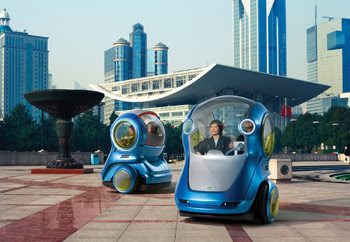
General Motors’ EN-V concept car is based on the two-wheeled Segway platform and can be driven manually or autonomously. ©General Motors Co.
By 2030, 60 percent of the world’s 8 billion people will live in urban areas, putting increasing strain on the cities’ public infrastructures. With this in mind, General Motors has introduced – in crowded Shanghai, appropriately enough – the EN-V concept car, based on the two-wheeled Segway platform. The EN-V, short for electric networked-vehicle, can be driven either manually or autonomously, the latter by combining global positioning system and vehicle-to-vehicle communication and distance-sensing technologies. The autonomous driving capability can help reduce traffic congestion, and it even allows for self-parking – with the driver hopping out wherever he or she needs to be and the car zipping off to find the nearest parking spot, returning when the driver summons it using a smartphone application.
Arm phaser banks and photon torpedoes!
Admit it: When you think of weapons of the future, you reflexively think of lasers, don’t you? Laser pistols. Laser rifles. Huge, planet-killing laser cannons housed in space stations the size of a small moon. From Flash Gordon to Star Trek to The Adventures of Pluto Nash, we have been conditioned to identify the future of weaponry almost exclusively with light amplification by stimulated emission of radiation.
But how plausible is this? Are we really likely to see, 20 or even 50 years from now, soldiers running around like Duke and Roadblock from the G.I. Joe cartoon of the 1980s, firing pulsed laser guns at all the bad guys storming their secret base in the New Mexico desert?
We almost surely will see laser weapons in the future – a number of systems are being tested even as you read this – but they likely won’t resemble those we’ve seen in the movies and on TV. The notion of lasers replacing bullets, for example, is basically a fantasy, said David C. Brown, founder, president and CTO of Halstead, Pa.-based Snake Creek Lasers. Instead, the applications envisioned for laser weapons include mounting the weapons on Humvees and other vehicles.
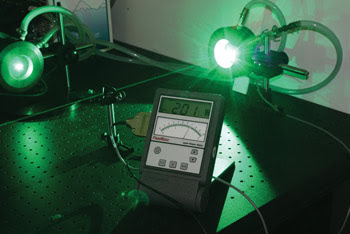
Researchers at Snake Creek Lasers are exploring the potential of cryogenic laser systems for military applications. Shown is a cryogenic laser in ultrafast mode being converted using a noncritically phase-matched LBO crystal, from 1029 nm in the infrared to 514.5 nm in the green. The company demonstrated more than 200 W of average output power. Without any focusing, the beam drilled through 2 in. of firebrick in 3 s. Courtesy of Snake Creek Lasers.
It may be some years even before some of these systems are ready to be deployed. Developers of the technology first will need to address several major challenges, including integrating the many components of the weapons systems and managing the thermal effects associated with doing so.
A variety of groups are looking at ways to tackle these challenges. Some are growing thermoelectric coolers in the form of thin films, others are probing the possibility of implementing massive microchannel cooling, and still others – Snake Creek Lasers and MIT’s Lincoln Lab are pioneers here – are exploring the potential of cryogenic laser systems.
Brown and colleagues at Snake Creek Lasers reported a high-sustained-average-power continuous-wave and ultrafast Yb:YAG near-diffraction-limited cryogenic solid-state laser in the November 2010 issue of Optics Express. In demonstrations of the laser, pulses exiting the system exhibited a full-width half-maximum pulse width of 12.4 ps, an energy per pulse of 15.2 µJ, peak power of 1.23 MW and average power >750 W.
The advantages of using such a system are significant, Brown noted. “One of the benefits of the cryogenic technology, especially with the Yb-based lasers, is that they can be operated not only with high average power and perfect beam quality, but also with high average peak power. It’s kind of the ultimate laser weapon, because now you have complete control over not just the beam quality or the profile, but also whether it is CW or pulsed. Effects can be produced that cannot be by CW-only operation.”
Besides relatively portable laser weapons systems facilitated by advances such as these, the future will bring us larger ship-based and airborne systems, where thermal management is less of a concern. Indeed, several are already being tested.
Last year, for example, the US Navy and Northrop Grumman Corp. demonstrated a high-energy, solid-state laser defense system at the Pacific Ocean Test Range near San Nicolas Island off the coast of central California. Installed on the Navy’s self-defense test ship, the USS Paul Foster, the system – dubbed the Maritime Laser Demonstrator (MLD) – tracked and lased land targets, then moved on to remotely piloted, unmanned small boats cutting across the water, successfully disabling those as well.
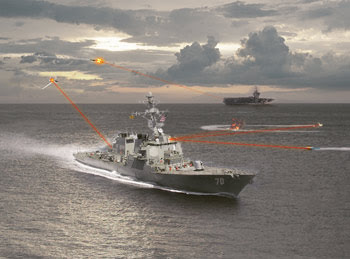
The future of maritime laser weapons systems, as interpreted by an artist. The actual emission wavelengths will be in the infrared range, rather than the visible. Courtesy of Northrop Grumman Corp.
The MLD system, operating at about 15 kW, was built leveraging the solid-state laser technology that the company developed under the US Defense Department’s Joint High Power Solid State Laser program, which demonstrated the ability to lase at 100 kW of energy.
Dan Wildt, vice president of directed energy systems at Northrop Grumman, said: “100 kilowatts is a ‘militarily significant’ power level because it enables a variety of force protection and strike missions, including self-defense from threats as diverse as rockets, artillery, mortar rounds, swarming boats, unmanned aerial vehicles and aircraft. It can also enable ultraprecision strikes from a variety of ground-, sea- or air-based platforms, for prosecution of enemy targets, while minimizing the risk of collateral damage.”
The open ocean tests also demonstrated that the MLD can effectively operate in a challenging maritime environment, overcoming obstacles such as atmospheric conditions, waves and the motions of both the host and target vessels, while also meeting precision tracking and beam delivery requirements for self-defense.

Last year, the US Navy and Northrop Grumman tested a laser system that could track and lase moving targets, overcoming challenges including atmospheric conditions and waves.
If all this is conjuring up images of Star Trek: Deep Space Nine’s Battle of Wolf 359, where Commander Sisko loses his beloved wife to the cybernetic Borg, or of Freddie Prinze Jr. piloting the carrier Tiger Claw against the armada of the catlike Kilrathi in the 1999 box-office flop Wing Commander, well, that wouldn’t be too far off base.
Programs such as the MLD and the Airborne Laser Test Bed suggest a future where battles are fought with lasers mounted on large, moving platforms, targeting missiles and drones as well as other craft with surgical precision.
It could happen. Indeed, it likely will happen within our lifetimes.
OLEDs and Lighting the “Flying Future”
Opinions vary as to whether and when OLED lighting will replace conventional incandescent and fluorescent bulbs. One recent report projected a relatively anemic OLED lighting market in 2020, for example, with annual sales of only $58 million; another saw a considerably larger $4.6 billion market by 2016.
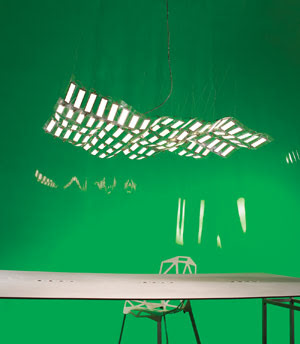
Photo by Tom Vack, Munich. ©Ingo Maurer GmbH, Munich.
One thing we can say with a degree of certainty: With their unique features, including diffuse lighting, flexibility and color tunability, OLEDs will be more and more widely used in designer lighting applications, where cost may not be as important a factor as it is with general lighting applications. Indeed, lighting designers are already taking advantage of these features to create a futuristic sort of look. One example: Designer Ingo Maurer produced the lighting project shown here, dubbed “Flying Future.”
Bus Stops Powered by the Sun
Kenneth McCauley, vice president of sales, marketing and business development at Konarka Technologies Inc. in Lowell, Mass., rebuked me ever so slightly when I asked him to describe what the solar power landscape will look like 20 or 50 years from now.
The industry is difficult to predict year to year, he said, so looking that far ahead can be like a rocket scientist who is a small fraction of a degree off in a calculation: This small error replicated billions of miles downrange in the flight path can leave you somewhere entirely different from where you anticipated ending up.
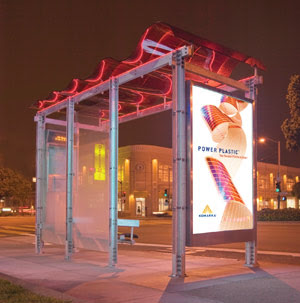
Advances in organic photovoltaic technology allow for flexible solar panels, which suggest a range of novel applications. Examples include a solar bus shelter (at right) and the solar curtain that attaches to the outer wall of a building. In the future, we could see much more of such solar panels incorporated into the design of buildings and other structures. Image courtesy of Konarka Technologies. Photo by Ryan Hughes.
“That said,” he continued, “I personally believe that 20 to 50 years into the future, and perhaps much earlier, distributed electrical (and other) power generation, much of it at point of use, will become so ubiquitous that we will cease to think of renewable energy as something novel or unusual.”
And just as we’ll likely see flexible OLED lighting integrated into architectural and interior designs, he hopes that we’ll see flexible solar panels – such as Konarka Power Plastic technology, based on a photoreactive polymer material that can be printed or coated onto flexible substrates using roll-to-roll manufacturing – integrated into automobile surfaces and building envelope design elements, for instance. Such technology could serve in any application where transparency, a color palette, light weight, flexibility and off-angle energy harvesting are useful design/performance elements.